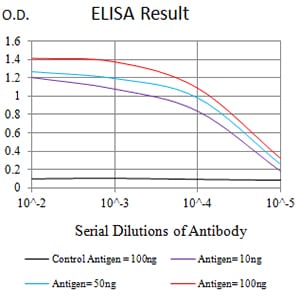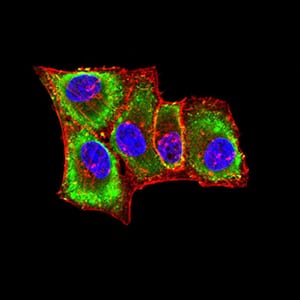


| WB | 咨询技术 | Human,Mouse,Rat |
| IF | 咨询技术 | Human,Mouse,Rat |
| IHC | 咨询技术 | Human,Mouse,Rat |
| ICC | 1/100 - 1/500 | Human,Mouse,Rat |
| FCM | 1/200 - 1/400 | Human,Mouse,Rat |
| Elisa | 1/10000 | Human,Mouse,Rat |
| Aliases | NOV; NOVP; PLXN1; PLEXIN-A1 |
| Entrez GeneID | 5361 |
| clone | 8A10A6 |
| WB Predicted band size | 211kDa |
| Host/Isotype | Mouse IgG1 |
| Antibody Type | Primary antibody |
| Storage | Store at 4°C short term. Aliquot and store at -20°C long term. Avoid freeze/thaw cycles. |
| Species Reactivity | Human |
| Immunogen | Purified recombinant fragment of human PLXNA1 (AA: 1100-1200) expressed in E. Coli. |
| Formulation | Purified antibody in PBS with 0.05% sodium azide |
+ +
以下是3-4篇关于PLXNA1抗体的参考文献及其摘要概括:
1. **"Plexin-A1 is a functional receptor for semaphorin 3A"**
- **作者**: Tamagnone L, et al.
- **摘要**: 该研究首次证实PLXNA1作为Semaphorin 3A的受体,通过免疫沉淀和抗体阻断实验,揭示了其在轴突导向和细胞迁移中的关键作用,为神经发育和癌症转移机制提供了依据。
2. **"PLXNA1 promotes cancer cell proliferation and metastasis in non-small cell lung cancer"**
- **作者**: Zhang Y, et al.
- **摘要**: 通过免疫组织化学和Western blot分析PLXNA1抗体标记的样本,发现PLXNA1在非小细胞肺癌中高表达,且与患者预后不良相关,提示其作为潜在治疗靶点的可能性。
3. **"Structural basis of plexin-A1 signaling complex activation by semaphorin-plexin interaction"**
- **作者**: Janssen B, et al.
- **摘要**: 利用PLXNA1抗体进行结构生物学研究,解析了PLXNA1与Semaphorin结合的分子机制,揭示了其胞内结构域信号转导的关键构象变化。
4. **"Plexin-A1 regulates the immune microenvironment in glioblastoma through macrophage recruitment"**
- **作者**: Zhou Q, et al.
- **摘要**: 通过抗体介导的PLXNA1功能抑制实验,发现其通过调控趋化因子释放影响巨噬细胞浸润,为胶质母细胞瘤的免疫治疗提供了新方向。
以上研究涵盖了PLXNA1在神经发育、癌症、结构生物学及免疫微环境中的功能,抗体应用包括免疫沉淀、Western blot、免疫组化和功能阻断实验。
The PLXNA1 antibody targets plexin A1 (PLXNA1), a transmembrane receptor belonging to the plexin family, which plays critical roles in cell signaling and communication. PLXNA1 primarily interacts with semaphorin ligands, mediating diverse biological processes such as axon guidance, cell migration, immune regulation, and angiogenesis. Structurally, it contains a large extracellular domain for ligand binding, a transmembrane region, and a cytoplasmic domain that transmits intracellular signals via Rho GTPases and other downstream effectors. Dysregulation of PLXNA1 has been implicated in neurological disorders, cancer progression, and vascular abnormalities.
PLXNA1 antibodies are essential tools for studying its expression, localization, and function in physiological and pathological contexts. They are widely used in techniques like Western blotting, immunohistochemistry (IHC), and immunofluorescence (IF) to detect PLXNA1 in tissues or cultured cells. Monoclonal antibodies offer high specificity, while polyclonal antibodies may detect multiple epitopes, enhancing sensitivity. Researchers also utilize PLXNA1 antibodies to explore its role in tumorigenesis, metastasis, and neural circuit formation, particularly in cancers (e.g., breast, prostate) where PLXNA1 overexpression correlates with poor prognosis.
Challenges include ensuring antibody specificity due to homology among plexin family members. Validation via knockout controls or siRNA knockdown is critical. Despite these hurdles, well-validated PLXNA1 antibodies remain indispensable for unraveling its complex signaling networks and therapeutic potential in disease models.
×